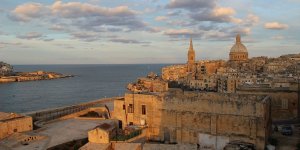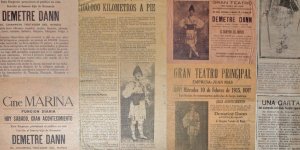| Published in Destinations |
Amalfi, Italy

View of Amalfi from the sea. Amalfi, Italy. ![]()
Amalfi is a town in the province of Salerno, in the region of Campania, Italy, on the Gulf of Salerno. It lies at the mouth of a deep ravine, at the foot of Monte Cerreto (1,315 metres, 4,314 feet), surrounded by dramatic cliffs and coastal scenery. The town of Amalfi was the capital of the maritime republic known as the Duchy of Amalfi, an important trading power in the Mediterranean between 839 and around 1200.
In the 1920s and 1930s, Amalfi was a popular holiday destination for the British upper class and aristocracy.
Amalfi is the main town of the coast on which it is located, named Costiera Amalfitana (Amalfi Coast), and is today an important tourist destination together with other towns on the same coast, such as Positano, Ravello and others. Amalfi is included in the UNESCO World Heritage Sites.
A patron saint of Amalfi is Saint Andrew, the Apostle, whose relics are kept here at Amalfi Cathedral (Cattedrale di Sant'Andrea/Duomo di Amalfi).
Get in
By bus
The SITA local bus network travels all over the Amalfi Coast. To and from Sorrento via Positano and Praiano and onwards to Furore Fjord, Conca and its Emerald Grotto. Buses also travel to and from Salerno from Amalfi via Minori, Minori, Cetara and Vietri. Local buses also link Amalfi to Ravello and the upper reaches of Furore, Pogerola, Agerola and Napoli.
Positano is approx. 40 minutes from Amalfi (depending on traffic). The trip to Amalfi from Sorrento is approx. 1 hour and 15 minutes (depending on traffic) otherwise this can blow out to two hours. July and August are prime months for people-moving so the buses can become very crowded so make sure you are at the front of the pushy crowd when the bus pulls up otherwise it is a long wait for the next one...
It is a comfortable way to travel along the Amalfi Coast and Sorrentine Peninsula on the bus, however if you are prone to motion sickness the hairpins on these roads will certainly induce symptoms very quickly! SITA offers a very efficient public transportation service in the area, with expert drivers who breeze along the winding roads like they were driving on a highway (you will be happy to know that they are experienced). Here is something that you might need to know to know before you board your bus.
1. You have to buy your tickets in advance, before you get on the bus. Tickets can be bought at caffe bars, some have a black and white sign 'Tabacchi' hanging out the front while some stores selling lotto tickets also sell bus tickets so look out for these too. Shops also which display the SITA logo as well as at the SITA ticket office at the Salerno train stations. If a bar does not sell SITA tickets, you can always ask where you can find them as they are generally helpful.
2. As you get on the bus you have to clip your ticket in the yellow/orange machine that you will see in front of you as you climb the steps. If you are not able to get the machine to clip your ticket, ask the driver to do it for you. Do not forget to clip the ticket: during your trip an agent will board the bus and ask to check the ticket. If the ticket is not clipped you will have to pay a fine.
By boat
The ferry season opens from Easter weekend and runs until mid to late October with connections from Amalfi to Positano, Salerno, Capri, Naples and Sorrento.
Headquartered in Naples, the Metro del Mare is an extension of urban public transport -- by sea. Operating since 2002, it connects the northern ports of Bacoli and Pozzuoli to Naples and from there goes to Sorrento, Positano, and Amalfi. The service runs from Easter through to October, with several boats a day between Naples and Positano. Check the local papers (Il Mattino or La Repubblica) for timetables or with Metro del Mare (not available in 2011, probably available again in 2012)
Headquartered in Amalfi, ferries are operated by Coop Sant'Andrea (a consorzio which includes Travelmar, Alicost and Linee Marittime Partenopee). Coop Sant'Andrea run the ferry service from Salerno to Amalfi, Amalfi to Salerno, Amalfi to Positano, Positano to Amalfi, Positano to Salerno, Salerno to Positano and connections in summer between Amalfi-Minori-Maiori. Schedule 2009 online.
Tickets can be purchased at the ticket booth located on the main pier in Amalfi called Molo Pennello or at Divina Costiera, an information point in Amalfi opposite the SITA bus terminal.
There are also private boat charters offered at the ticket kiosks on the Molo Pennello pier.
Boat and Ferry Information:
• Travelmar (Ph: 089/871483).
• Alicost (Ph: 089/871483).
• Alilauro (Ph: 081/8073024).
• Alilauro-Gruson (Ph: 081/8071430).
• Caremar (Ph: 081/8073077).
• Linee Maritime Salernitane (Ph: 089/873301 in Amalfi; 089/811164 in Postiano; 081/8073024 in Sorrento). Positano ferry and hydrofoil ticket office (Via del Brigantino, Italy. Ph: 089/811986).
• Travelmar (Ph: 089/872950).
• For ferry and bus timetables in English you can also refer to Amalficoast-Web.
By train
The two main train stations serving the Amalfi Coast are Salerno which has direct Eurostar and inter-regional trains connections to Naples and Rome and the local Circumvesuviana over in Sorrento which is the main train line which connects Sorrento to Naples and importantly, Sorrento to Pompeii ruins.
Conveniently, both stations are also hubs for cheap, efficient bus and ferry services radiating toward the major tourist destinations along the Amalfi Coast and inland.
By car
It is simple to hire a car for your stay - but driving in southern Italy is not for the faint-hearted! The Amalfi Coast roads are very narrow and cliff-hanging, and will provide a challenging drive, but there are many spots to stop along the coastal roads and small towns that are only easily accessible if you have your own car.
For those who are truly adventurous, scooters can be a practical form of transport, however precision driving is key.
The ferry and bus services on the Amalfi Coast offer excellent connections between towns and the price of parking could also put you off hiring a car.
Amalfi is 270 km from Rome, 70 km from Naples, 60 km from Avellino and 85 km from Caserta.
Airports
The nearest airports are:
• Salerno-Pontecagnano Airport (QSR) 45 km
• Napoli-Capodichino (NAP) 74 km
Main sights
Amalfi occupied a high position in medieval architecture; its cathedral of Sant'Andrea (Saint Andrew, 11th century), the campanile, the convent of the Cappuccini, founded by the Amalfitan Cardinal Pietro Capuano, richly represent the artistic movement prevailing in Southern Italy at the time of the Normans, with its tendency to blend the Byzantine style with the forms and sharp lines of the northern architecture.
Cathedral
At the top of a staircase, Saint Andrew's Cathedral (Duomo) overlooks the Piazza Duomo, the heart of Amalfi. The cathedral dates back to the 11th century; its interior is adorned in the late Baroque style with a nave and two aisles divided by 20 columns. The façade of the cathedral is Byzantine in style and is adorned with various paintings of saints, including a large fresco of Saint Andrew.
The gold caisson ceiling has four large paintings by Andrea dell'Asta. They depict the flagellation of Saint Andrew, the miracle of Manna, the crucifixion of Saint Andrew and the Saint on the cross. From the left hand nave there is a flight of stairs which leads to the crypt. These stairs were built in 1203 for Cardinal Pietro Capuano, who, on 18 May 1208, brought Saint Andrew's remains to the cathedral from Constantinople.
The bronze statue of Saint Andrew in the cathedral was sculpted by Michelangelo Naccherino, a pupil of Michelangelo; also present are Pietro Bernini marble sculptures of St. Stephen and St. Lawrence.
In 1206, Saint Andrew's relics were brought to Amalfi from Constantinople by the Pietro Capuano following the Sack of Constantinople (an event of the 4th Crusade) after the completion of the town's cathedral. The cathedral contains a tomb in its crypt that it maintains still holds a portion of the relics of the apostle. A golden reliquary which originally housed his skull and another one used for processions through Amalfi on holy days can also be seen.
Chiostro del Paradiso
The Chiostro del Paradiso ("Cloister of Paradise") was built by Filippo Augustariccio between 1266 and 1268 and was used as a burial ground for noble families of Amalfi. The white columns and pointed arches reflect the clear influence that the Arab world had on Amalfi, similar to those found in the courts of the palaces of the Middle East. It is a true open-air museum, with Roman and medieval pillars, sarcophagi depicting the wedding of Peleus and Thetis, the other the rape of Proserpina, a fourteenth-century sarcophagus and fragments of the façade of the Duomo.
Arsenal of the Maritime Republic (Gli Arsenali della Repubblica)
The structure of the arsenal consists of two large stone-built halls with vaulting supported by repeated pointed arches. The vaulting rests on ten piers, originally there were twenty two, the missing twelve and the structure they supported having been lost to centuries of coastal erosion. The main function of the arsenal was the building, repair and storage of warships. Amalfitan war-galleys were among the largest to be found in the Mediterranean during the Early Middle Ages.
The building now contains architectural and sculptural remains, a row-barge used in the Historical Regatta, a number of models of ships and it also acts as a venue for visual art exhibitions. Starting from December 2010, the Ancient Arsenals of Amalfi host the Compass Museum on the premises of the two aisles of the building, which were spared by the Amalfi seaquake of 1343.
Museum of Handmade Paper (Museo della Carta)
The Museum of Handmade Paper, located in Mill Valley in the northern part of the modern town, celebrates the long-established paper making tradition in Amalfi. The town was one of the first centres of paper making in Europe, the skill having been acquired by the Amalfitans from the Arabs.
The museum is housed in an ancient paper mill which was once owned by the Milano family, a family famous in Amalfi for its involvement in the production and manufacture of paper. In 1969 the building was converted into a museum as a result of the will of Nicholas Milano, the mill's then owner. The museum contains the machinery and equipment (restored and fully functional) that was once used to manufacture paper by hand.
Do
• The beach can be crowded in summer, particularly in August when Italians are on holiday and let their kids loose for the month on the strip of pebbled beach.
• Evening walk along the marina to where the mega-yachts dock in summer time.
• The Amalfi Coast to Capri Boat Excursion is a full-day sightseeing tour taking in all the Amalfi Coast villages, including Ravello, Positano, Atrani, Praiano, Maiori and Minori. You visit the grottos in Capri and Amalfi, you can go swimming directly from the boat, the tour circumnavigates Capri island and you have the opportunity to disembark in Capri for three hours of your own time before you cruise back at about 6pm. Departures from Amalfi, Maiori and Minori.
• A half-day Amalfi to Positano Cruise is also offered by Amalfi Boat Excursion and is perfect for travellers with limited time.
• That's Amore Cycling Excursion offer in every season exclusive guided and customized cycling exploration of the coast : short and easier route and a longer or more demanding route for the keener cyclists. Booking Required.
• Hiking in the Valle delle Ferriere from the Valle dei Mulini locality upwards through the Valle delle Ferriere and back to Chiorito locality.
• Napoli Amalfi Tour Guide. offer all kind of tours and excursions in Amalfi, Positano, Ravello, Vietri, and to other places in the surroundings too (Pompeii, Salerno, Paestum, etc.). An expert private guide who also takes one to the best gastronomic stops, insider's cafés, restaurants and food producers.
Get out
• The Emerald Grotto (La Grotta dello Smeraldo), is 5 km West of Amalfi town on the main coastal road heading in the direction of Positano. It is situated in the town of Conca dei Marini. There are daily boat excursions of one-hour which leave Amalfi taking guests to the Emerald Grotto. Visit the grotto and sightsee part of the striking Amalfi Coast.
Ferry cruises leave daily from 9am, on the hour with the last boat at 3.30pm as the grotto closes at 4pm. You can also arrive at the grotto by the local SITA bus network which stops above the cliff where the grotto is housed in Conca. You then descend down to the grotto by lift. Take the Positano or Sorrento SITA bus from Amalfi and get off at Conca, about 20 minutes into the journey.
• Ravello, 6 km North East of Amalfi. The City of Music, is thirty minutes away by public bus and offers beautiful views of the coast. Villa Cimbrone is a superb afternoon of wandering around its gardens and sculptures.
• Positano is a short and scenic 25 minute ferry trip away from Amalfi. And the best way to full appreciate this beautiful town is to arrive by sea.
• Atrani, 1 km East of Amalfi, is a neighbouring and pretty town and only ten minutes from Amalfi by foot.
• Furore is about 25 minutes from Amalfi by SITA bus or car via the main Amalfi to Positano coastal road. This town hosts the famous Fjord of Furore, a secret cove with fisherman's houses.
• Agerola is about 45 minutes from Amalfi by SITA bus, car or by bicycle(this last solution is adviced if arranged with local bike tour operators) via the main Amalfi to Agerola coastal road. This town hosts the famous cheeses named Fiordilatte (milk flower).
• Valle delle Ferriere, 7 km west of Amalfi

Amalfi, cathedral. Amalfi, Italy. ![]()
YOU MAY ALSO LIKE





 If you own or manage a travel-related business such as a hotel, a bed-and-breakfast, a restaurant, a pub or a cafeteria, you can create a web page for your business for free on Titi Tudorancea Travel Info. » |
